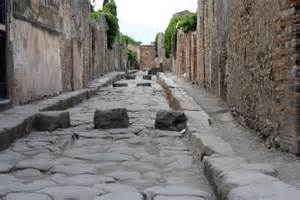
As you wander around Pompeii,it is strange to think that you are walking along the same pavements and streets as people did over 2000 years ago. The roads are paved with slabs of grey,volcanic rock from Vesuvius - just like the streets of nearby Naples today.
当你在庞贝城漫步,你会吃惊地想到这是走在2000多年前的人们修建的街道上。街面铺者灰色的平板砖、维苏威火山的火山岩——就像今天那不勒斯附近的街面一样。
The pavements were a lot higher than the level of road - for a very good reason. Not only did the road act asa drain for rainwater,but it also carried away a lot of rubbish and even sewage. This made it rather unpleasant to cross,so there were stepping stones to help people keep their feet clean.
人行道比街道的水平面稍微高一些——的确有理由做成这样。不仅使马路成为雨水的排水沟,而且带走了许多垃圾甚至是污水。这样设计就使得横穿马路成为一件不让人愉快的事情,所以马路中间还有分级的石阶以帮助人们保持脚的干净。
The stepping stones were arranged with gaps so that the wheels of carts could pass through. We know that the streets of Pompeii carried a lot of wheeled traffic,because there are deep grooves where the wheels have worn away.
分级的石阶铺设得有间隙,这样大车的轮子就能通过了。我们知道庞贝城的街道承载了大量轮运交通,因为在那些车轮已经消逝的今天,它们深深的车辙还保留着。












